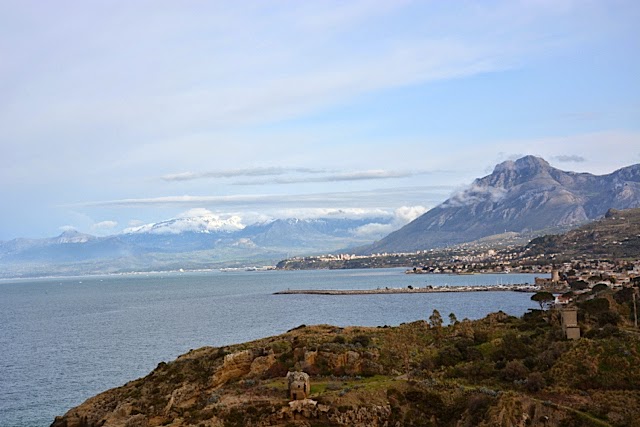After Naples and Pompeii, the four wanderers (Bert, Charley, and we) spent a few days in Praiano on the Amalfi Coast. I have to admit that I had no idea what the nature of the scenic attractions were here, and so it was a discovery to find that staying here is an exercise in cliff-hanging. Here are a few pictures to give you the idea.
 We drove the autostrada through the middle of Sicily through a deluge, but eventually the skies began to clear and we got a view of Mt. Etna.
We drove the autostrada through the middle of Sicily through a deluge, but eventually the skies began to clear and we got a view of Mt. Etna.
We were starving when we reached the north coast, so we got off the autostrada and followed the coast road looking for a place to eat. We stopped at three places that were closed and were starting to wonder if we would have to drive the remaining 30 kilometers into Palermo to find an open restaurant. We entered a small town (didn't catch the name) and decided to try one more time with a little storefront trattoria. They were open. We were so relieved. And as often happens in Italy, this little place had a wonderful ambiance and fantastic food. Here are a few photos:
From Amalfi to Lake Como to Cinque Terre, the Italians have had a knack for building in impossibly steep locations. It is even more amazing to think that they have been doing this since medieval and renaissance times when building supplies were moved on the backs of animals. A reminder of this: at one point on the road we saw a man leading a donkey that had saddlebags full of lumber. And for excitement, nothing beats the adrenaline rush of driving a car on a narrow twisting road on the side of a cliff where you have to slow down and get close to the edge to squeeze by oncoming cars, while being tailgated by three cars that are just itching to pass you. Then you hear a booming honk from around a blind turn and a huge tour bus confronts you.
After Amalfi, the four wanderers split up, Bert and Charley heading for Matera at the south end of Italy, while we hopped a plane for Catania, Sicily. We intended to check out the Greek ruins at Taormina on our first full day there, but we were greeted by heavy rains, so we decided to just make the drive to Palermo instead.
Those who know me well have heard me repeat, in appropriate situations, my favorite quote, "they're more what you'd call 'guidelines' than actual rules." This perfectly captures how Italians regard traffic laws. But even within Italy, there is a wide variation. In our locale of Tuscany, everyone is looking out for others while bending the rules. In Sicily, it is every person for him/herself. My best example of this was when we were leaving Catania, driving down a wide boulevard. Approaching a somewhat crazy intersection, the light turned red but cars on both sides of me did not stop. In the type of instantaneous decision one makes in a case like that, I ran the red like everyone else to avoid getting rear-ended or at least honked at.
Those who know me well have heard me repeat, in appropriate situations, my favorite quote, "they're more what you'd call 'guidelines' than actual rules." This perfectly captures how Italians regard traffic laws. But even within Italy, there is a wide variation. In our locale of Tuscany, everyone is looking out for others while bending the rules. In Sicily, it is every person for him/herself. My best example of this was when we were leaving Catania, driving down a wide boulevard. Approaching a somewhat crazy intersection, the light turned red but cars on both sides of me did not stop. In the type of instantaneous decision one makes in a case like that, I ran the red like everyone else to avoid getting rear-ended or at least honked at.
 We drove the autostrada through the middle of Sicily through a deluge, but eventually the skies began to clear and we got a view of Mt. Etna.
We drove the autostrada through the middle of Sicily through a deluge, but eventually the skies began to clear and we got a view of Mt. Etna.We were starving when we reached the north coast, so we got off the autostrada and followed the coast road looking for a place to eat. We stopped at three places that were closed and were starting to wonder if we would have to drive the remaining 30 kilometers into Palermo to find an open restaurant. We entered a small town (didn't catch the name) and decided to try one more time with a little storefront trattoria. They were open. We were so relieved. And as often happens in Italy, this little place had a wonderful ambiance and fantastic food. Here are a few photos:
wine rack, harnessing gravity
wall with decorative plates
A garden patio in the back of the trattoria. Small storefront restaurants often surprise you in magical ways in Italy.
After lunch we stopped at a view point where, with the weather clearing, we could see east to Mt. Etna and west to our destination, Palermo.
Travels are brief summaries of life lessons. We were planning and looking forward to seeing the remains of an ancient civilization, but the weather did not cooperate. We had modest expectations for Palermo, but what we found was...well, that is the story for the next blog.
Mt. Etna in the distance
Palermo ahead
Travels are brief summaries of life lessons. We were planning and looking forward to seeing the remains of an ancient civilization, but the weather did not cooperate. We had modest expectations for Palermo, but what we found was...well, that is the story for the next blog.































